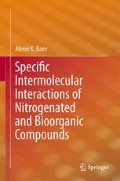Abstract
The simplest oxazole molecules and its derivatives with two hetero atoms in the cycle exclude the possibility of understanding the specificity of the formed interactions with the use of ideas of sp3-hybridization [1–7]. The increased ability of the oxygen atom to shift of the electron density predetermines the increased positive charge of the carbon atom, at location С(2), located between these atoms. Therefore, the interaction of the oxygen atom with carbon atoms at locations С(2) and С(5) leads to the four interactions of one type, D–O → CH, in the structure of liquid oxazole with the network of specific interactions with increased stability
Access this chapter
Tax calculation will be finalised at checkout
Purchases are for personal use only
References
Baev AK, Korolkov DV (2003) Phenomenon of dative bonds in elementorganic compounds with alkyl ligand. Abstract XVth FECHEM conference on organometallic chemistry. University of Zurich, p 350
Baev AK (2003) Novel Approaches to the structure of functional solvents and elementorganic compounds with abstract international conference on solution chemistry, Debrecen. p 79
Baev AK (2004) Insolvence of model sp3-hybridization of carbon atom and chemistry of non aqua solutions. IX international conference. The problem of solvation and complex formation in solutions, Plyos, pp 62–64
Baev AK (2004) Lack of co-ordination thermodynamic properties of elementorganic compounds with sp3-hybridization of carbon atom and its insolence. Russian scientific symposium on thermo chemistry and calorimetry, Niznie Novgorod, pp 40–41
Baev AK (2009) Phenomenological significance of nonidentical sp3-hybridization model and a nature of interaction in chemistry of liquid non-electrolites and chemical thermodynamics. Abstracts. In: X international conference on physical and coordination porphyrin’s chemistry and their analogous (ICPC-10), Ivanovo, p 86
Baev AK (2012) Specific intermolecular interactions of organic compounds. Springer, Hiedelberg/Dordrecht/London/New York, 434p
Schustorovich EM (1978) Chemical bonds in coordination compounds. Knowledge, Moscow, p 434
Chickos JS, Acree WE (2002) Enthalpies of vaporization of organic and organometallic compounds, 1880–2002. J Phys Chem Rev 31(2):537
Baev AK (1969) Problems of chemical nature of phase transformation. In: General and applied chemistry, vol 1. Vysheischaia Educating, Minsk, pp 197–206
Baev AK (1969) Phase condition and complex formation ability of halogenide metals. In: General and applied chemistry, vol 1. Vysheischaia Educating, Minsk, pp 207–218
Baev AK (1987) Chemistry of gas-heterogenic systems of elementorganic compounds, Science and technology. Vysheischaia Educating, Minsk, 174p
Chickos JS, Acree WE (2003) Enthalpies of sublimation of organic and organometallic compounds, 1910–2001. J Phys Chem Rev 32(2):519
Armstrong DR, Perkins PG (1969) Calculation of the electronic structures and the gas-phase heats of formation of BH3, NH3, and BH3,CO. Inorganic physical theoretical. J Chem Soc 7(7):1044–1048
Kahn O (1969) Semi-empirical determination of electron transfer in complexes by a quantum chemical method. J Chim Phys 66:869
Gurianova EN, Goldshtain IG, Romm IP (1973) Donor-acceptor bonds. Chemistry, Moscow, p 397
Veillard A, Levy B, Danbll R, Gallais F (1967) Structural electroniqul of borazane BH3-NH3. Theor Chim Acta 8:312
Moireau MG, Veillard A (1968) Quantum mechanical calculations on barriers to internal rotation. II. The borazane molecular BH3-NH3. Theor Chim Acta 11:344
Veillard A, Daudel R (1970) Nature et proprieties des liaison de Coordination. Colloques internationaux du centre National de la Recherche Scientifigue, Paris, p 22
Kudchadk SA, Rao CNR (1970) Extended Huckel calculations on N-V addition compounds. Theory Chim Acta 18:258
Ehrenson S (1968) Theory of electron effect at formation of complex of trimethylamine with trimethylborium. Theor Chim Acta 10:193
Ehrenson S (1968) Effect environment at examination of a reactivity adding of trimethylamine to trimethylborium. Theory Chem Acta 10:209
Boer FP, Newton MD (1966) Molecular orbital’s for boron hydrides parameterized from SEF – model calculations. J Am Chem Soc 88:2361–2366
Author information
Authors and Affiliations
Rights and permissions
Copyright information
© 2014 Springer-Verlag Berlin Heidelberg
About this chapter
Cite this chapter
Baev, A.K. (2014). Specific Intermolecular Interactions of Nitrogen and Oxygen Containing Cyclic Hydrocarbons. In: Specific Intermolecular Interactions of Nitrogenated and Bioorganic Compounds. Springer, Berlin, Heidelberg. https://doi.org/10.1007/978-3-642-37472-2_7
Download citation
DOI: https://doi.org/10.1007/978-3-642-37472-2_7
Published:
Publisher Name: Springer, Berlin, Heidelberg
Print ISBN: 978-3-642-37471-5
Online ISBN: 978-3-642-37472-2
eBook Packages: Chemistry and Materials ScienceChemistry and Material Science (R0)

